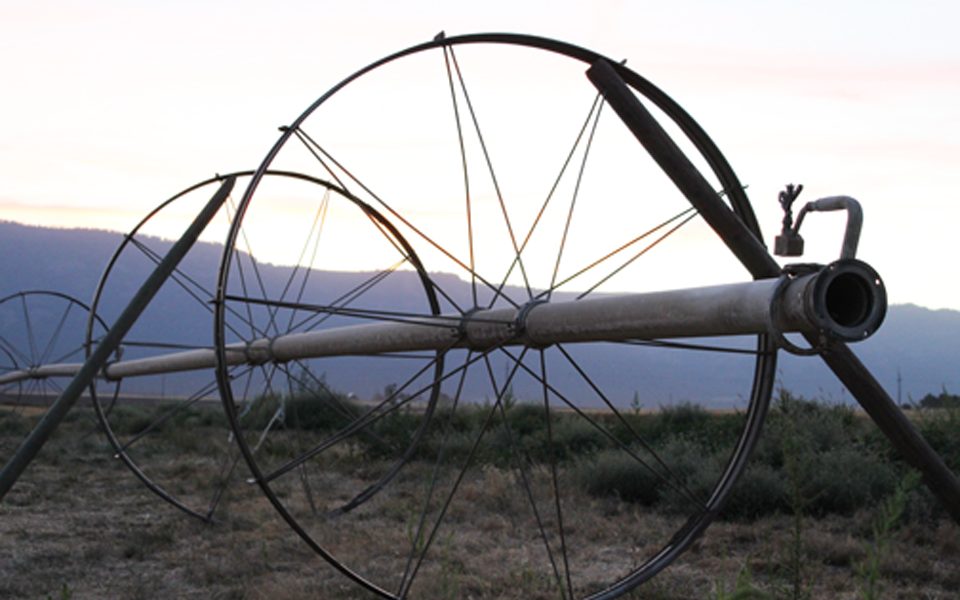
By Pat Caldwell
The Enterprise
VALE — Pittsburgh had its steel and in Texas it was oil but for Malheur County the lifeblood of its economy is water.
And this year there will be plenty of the wet stuff, a sharp contrast to previous growing seasons when drought conditions existed in area reservoirs and irrigation canals.
Ample water means a good year for local farmers.
“That means we will plant every acre that we were planning on. The last couple of years we had to lay some fields off and we had to be a little more selective with our rotations,” said Nyssa armer Dan Corn said.
Crop rotation is important, Malheur County Extension Agent Stuart Reitz said.
“The last couple of years, back when we had low water allotments, it forced a lot of ground to be left fallow. Then that meant people swapping fields around to put crops where they had water so it upset the rotations,” he said.
Crop rotation combats erosion, improves soil stability and can cut down on pests.
“It just takes another risk factor out of raising your crop through the year. Not having to deal with water shortage helps considerably,” said Adrian farmer Brent Ishida.
While the 2017 winter pounded the county, it also laid the groundwork for an excellent water year.
Statistics tell only part of the story but the numbers connected to water availability locally are impressive.
A good example is the Owyhee Reservoir. The water level at the reservoir was at 128 percent of average and by March 20 held more than 500,000 acre feet of water for the first time since 2012.
Snowpack, precipitation, runoff of the snowpack and the subsequent stream flow all play key roles in how a water year shapes up for area farmers. So far, the region is doing well in three of those categories with high predictions set for the fourth.
The snow pack for the Owyhee and Malheur basins was 139 percent of normal as of March 1. The Lookout Butte marker set a new record for March 1 snowpack with a measurement of 2.4 inches of snow water. The Lookout Butte marker has been measured since 1961 and it is typically snow-free by March 1.
The Bully Creek marker also set a record high – on March 1 – of snowpack of 9.2 inches of snow water – five times normal.
February precipitation in the basin was good as well – 140 percent of average – and officials expect the April through September stream flow to range from 160 percent to 237 percent of average.
In short, precipitation during the winter helped build an above-average supply of water with enough snow in the mountains to keep the faucet on deep into the irrigation season.
Mary Mellema, U.S. Bureau of Reclamation hydrologist, said the frequency of the storms during the winter made the difference regarding water reserves.
“In a lot of years you’ll have a big month then you’ll have a month where you don’t have a lot of (snow) accumulation. This year it started in January and kept on coming,” Mellema said.
Jay Chamberlin, Owyhee Irrigation District manager, said the water year has been shaping up for months.
“It started way back in October with well above precipitation,” he said.
The Owyhee Irrigation District serves about 1,800 customers and provides water for 120,000 acres.
Three of the region’s four reservoirs showed solid or exceptional water levels last week.
For example, as of March 20, the Owyhee Reservoir – which holds Lake Owyhee – is 88 percent full while Bully Creek Reservoir is 75 percent full. Beulah Reservoir stands at 87 percent full. Warm Springs Reservoir was 69 percent full.
Chamberlin said he is especially pleased by the amount of water still locked into the mountains around the region.
“We have still got 600,000 million acre feet of water out there that is supposed to come out between March 1 and the first of July,” he said.
The amount of water in Lake Owyhee, Chamberlin said, bodes well for the future.
“For us on the Owyhee system, this takes care of us two years out because we have storage carried over,” he said.
The abundance of water wasn’t expected, Chamberlin said. That’s because forecasts predicted a warmer and wetter – more snow and less rain – winter season.
“This is really quite a surprise,” he said. “This has really been one of those bumper years where it proved a lot of theories wrong,” he said.
At the Vale Oregon Irrigation District, which serves more than 400 customers, manager Dan Fulwyler remains cautiously optimistic. The water season could hinge on how much runoff drops from the mountains between April and June, he said.
“With the snow pack we are optimistic they (the reservoirs) will fill OK. It is setting up to be a pretty good year,” Fulwyler said.
Fulwyler said he was also surprised by the wet winter.
“This was more than what we expected,” he said.
Mellema agreed with Chamberlin that the 2017 water campaign will secure a big boost from run-off.
“We are looking at a well above average runoff,” she said.
Randy Kinney, Warm Springs Irrigation District manager, said runoff is critical but how it falls from higher ground into the basin is also important.
“If it comes off correctly we would fill the reservoir plus some. As of right now it all depends on how it comes off,” he said.
That means, he said, the snowpack must melt at a steady rate and temperatures at night must remain above freezing. If the temperature does dip and freeze, the snowpack water flow slows and begins to filter into the ground instead of pouring into the Warm Springs Reservoir.




